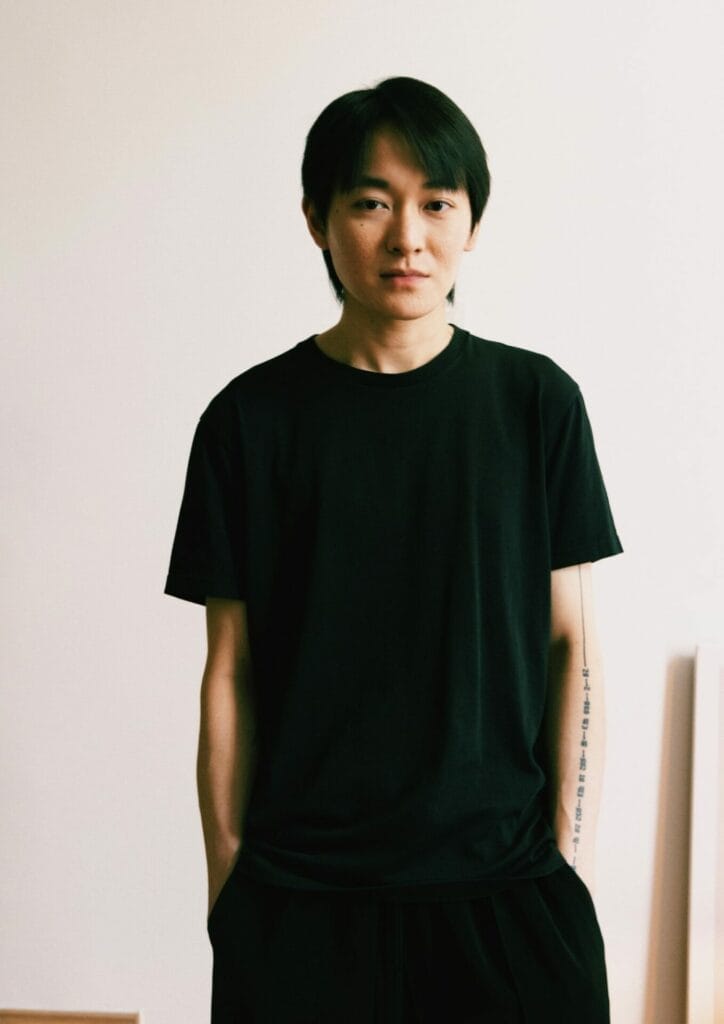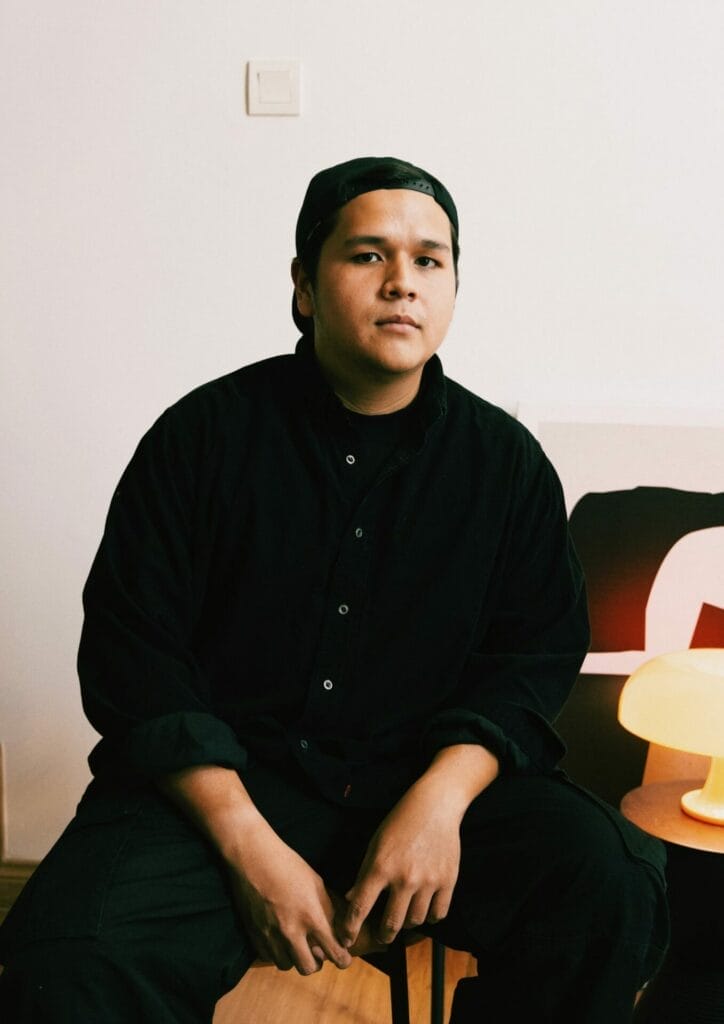We tasked six Malaysian designers to interview each other, on anything they’ve ever wanted to know about their peers.
Shot on location at Masyadi’s Showroom. Photography by Aiman Yazid. Text by Ainina Hasnul.
In Conversation with Kit Woo and Masyadi Mansoor of MYSD.

I entered Masyadi Mansoor’s showroom for the first time and was met with his welcoming smile. Although we had briefly crossed paths during Kuala Lumpur Fashion Week, I had never had the opportunity to truly get to know this boundary-pushing designer. Despite his daring designs for his label MSYD, which had earned him two awards from the Kuala Lumpur Fashion Awards (KLFA) 2023, Masyadi, affectionately known as Adi, had a charming demeanour, revealing that he considers himself an introvert. In the corner of the showroom, where his sewing machine and racks were filled with his famous puffer designs, lies the heart of his creativity.
Moments later, Kit Woo arrived. Clad in all black, echoing the enigmatic essence of his designs, Kit carried an aura of mystery. His canvas, mostly black, focused on cut, draping, and shape, reflecting the layered artistry behind his creations. Similarly, Kit himself seemed to embody this depth. As the three of us sat together, engaging in an interview where these two designers questioned each other, I gained a unique insight into their creative processes.
Step inside this exclusive interview between Kit Woo and MSYD to delve deeper into their perspectives.

Masyadi Mansoor (MM): How do you balance staying true to your artistic vision while also meeting the demands of commercial success?
Kit Woo (KW): Finding the balance between staying true to my artistic vision and meeting the demands of commercial success has always been a challenge. Clients often seek more wearable designs, but I’m driven by my desire to create whatever inspires me. However, running a business means we must sell our creations. So, it’s about striking a balance. There needs to be a bit of craziness, but also something relatable.
This often results in larger collections with more variation. I remind myself to stay true to my vision. Sometimes, when people suggest ideas that don’t align with my aesthetic, I nod politely but ultimately follow my instincts. This approach has been my survival tactic, both in college and in my career, helping me to remain authentic.

Photo by Aiman Yazid
KW: During your design process, what is that one detail that will always come back even when you are not intentionally featuring it? Something that manifests naturally in your process.
MM: During my design process, there’s one detail that consistently emerges, even when I don’t intentionally feature it: puffiness. I’m drawn to the drawstring effect because I appreciate volume in my designs. I find that if I create a garment that lacks dimension, it feels too flat for my taste.
So, I experiment with various fabrics and play with the balance of the material to achieve the desired puffiness. When clients approach me for custom pieces, I always ensure that my signature puffiness is incorporated, even in unexpected pieces like biker jackets. This detail is integral to my design DNA, as I enjoy working with volume and playing with silhouettes. I find immense satisfaction in the creative process.
MM: If you could collaborate with any artist, designer, or creative figure, who would it be and why?
KW: Choosing a collaboration partner is tricky for me because I’m not limited to the fashion industry. I might lean towards collaborating with someone from an industrial field, like a rubber maker. I envision exploring materials from a fashion perspective, inspired by my graduate collection where I experimented with industrial rubber. It was challenging but intriguing to work with non-fabric materials.
Another possibility could be collaborating with a 3D printing company to develop innovative designs. While 3D printing is not new, I’ve yet to explore it myself. Alternatively, collaborating with experts in textiles or materials, perhaps experimenting with techniques like dry dyeing, could also be fascinating. Ultimately, I have no one specific in mind, but I’m particularly drawn to collaborations involving textiles or materials.

Photo by Aiman Yazid
KW: You mentioned that you are launching a Ready-To-Wear (RTW) collection. What are your thoughts on retail in Malaysia? And any plans to sell internationally?
MM: My focus is currently on studying my market and followers. Most of them are admirers of my work rather than active consumers, primarily students and enthusiasts. As for my RTW collection, I intend to start with staple, essential pieces to cater to the needs of my audience. These will include basic items like t-shirts with added focus on intricate details.
Additionally, I’m experimenting with bags, paying attention to details such as zipper functionality and user experience. Initially, I aim to keep the collection affordable and accessible, offering basic shirts and socks as starting points. Although there’s a demand, I’m cautious about pricing, considering whether to align with designers prices or offer more affordable options. My ultimate goal is to expand internationally, but for now, I’m focusing on establishing a solid foundation locally before considering higher price points.
MMr: What do you consider to be the biggest challenge facing the fashion industry today, and how do you address it in your work?
KW: The fashion industry faces significant challenges today, one of which is the pressure to produce or overproduce, maintaining ready-to-wear stocks to meet demand. While the pandemic offered a momentary slowed-down industry pace, the return to rapid production poses new challenges. Keeping up with the demands of the calendar amidst constant change is a struggle.
There’s also always the challenge of new graduates entering the scene and gaining traction with similar offerings, potentially overshadowing established work. However, the bigger challenge lies in production management, which is more complex and unpredictable than designing itself. Dealing with constant changes in suppliers, fabrics, and unexpected disruptions adds another layer of difficulty. Ready-to-wear production, in particular, is challenging due to its scale. So, I try to find reliable suppliers whom we can trust in the production process.

Photo by Aiman Yazid
KW: As a unisex designer myself, we are usually put into that “streetwear” box at debut. Will you dive into other categories or expand from the current title as the “Streetwear Brand of The Year” at KLFA 2023?
MM: I see MSYD as my own unique take on streetwear. However, I want to offer something different within the Malaysian streetwear scene. Instead of completely shifting gears into a new category, I’m excited to explore new dimensions within streetwear. It’s just more “me” to stick with what I enjoy doing. Streetwear, to me, is all about self-expression, and there’s so much room for creativity and exploration within this category.
MM: What would you do differently if you were building your brand from the start now?
KW: To begin with, I didn’t initially plan to start my brand—it happened almost accidentally. I studied in the US and worked there for a year. I intended to stay after securing a junior designer position at Nike. However, complications arose, and the cost proved to be too high, so I returned to Malaysia. Initially, I pursued my brand as a side gig, but it wasn’t until KLFW 2016 that I decided to go full-time with it, thus officially starting the brand.
Looking back, one thing I would have done differently is not to start too soon. Instead, I would have focused on building a team who share the same vision and values. Additionally, I would have devised a comprehensive plan from the outset, outlining a five-year trajectory, projected expenditures, and allocation of resources. Starting without a clear plan led to a lot of learning along the way, and I believe I would have been better prepared if I had taken the time to plan meticulously from the beginning.

Photo by Aiman Yazid
KW: I understand that you also have a day job, and you continue to work on your own business after working hours. I’m curious to experience a day with Masyadi Mansoor. What’s that like?
MM: My full-time job runs from 9 am to 6 pm, but it’s not overly demanding. During lunch breaks, I dash home to work on my designs, occasionally contacting fabric suppliers in the mornings. My colleagues at work aren’t aware of my fashion endeavours since they don’t come from a fashion background.
Once I leave the office at 6 pm, I take a quick shower and nap before diving back into fashion work at 10 pm. I typically work until 2 am, and during KLFW, I’m known to put in 24-hour shifts. While burnout is a possibility, I find that I’d rather exhaust myself from pursuing my passion than feel drained from unproductivity.
MM: Where do you see yourself in 5 years from now?
KW: In five years, I envision my company participating more overseas, although careful preparation will be key. Showrooms can be expensive; I recall our venture to Paris in 2016, where we stayed at a showroom for eight days. We also had another experience in China, which was more positive. However, due to the pandemic, I’ve shifted focus to fully local endeavours. Nevertheless, I remain hopeful for the opportunity to resume showroom activities soon.
On a personal level, my goal is to expand my role as a sample maker, offering services for first drafts, patents, and sample making. I may explore small-scale production down the line, I believe it will ensure my ongoing growth and creativity.
KW: Any upcoming shows in 2024?
MM: I’ll be returning to KLFW. Additionally, in March, I had a collaboration with Nike for AirMax Day, featuring a small capsule collection and a mini fashion show for the event. For now, the only confirmed upcoming show I can share is KLFW.



